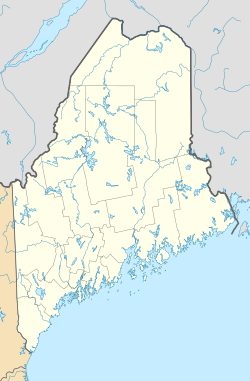Brown House (Brownville, Maine) facts for kids
Quick facts for kids |
|
|
Brown House
|
|
| Location | High St., Brownville, Maine, United States |
|---|---|
| Area | 0.5 acres (0.20 ha) |
| Built | 1815 |
| Built by | Francis Brown |
| NRHP reference No. | 85000273 |
| Added to NRHP | February 14, 1985 |
The Brown House is a very old and special house in Brownville, Maine, United States. It was built way back in 1815 by Francis Brown. The town of Brownville is actually named after his family! This house is famous for a cool design trick: its second-floor ceiling seems to float without touching the walls. The Brown House was added to the National Register of Historic Places in 1985 because it's so important.
Contents
What Makes the Brown House Special?
The Brown House is a large, two-and-a-half-story building. It has a classic look with a sloped roof and two chimneys inside. The outside is covered in wooden boards and it sits on a strong granite foundation. A smaller section extends from the back, connecting it to a barn.
Unique Design Features
The main front door is in the middle of the house. It has a fancy design with tall, thin columns and windows on the sides. There's also a window above the door. All the other windows have simple, molded frames.
The most amazing part of the house is the ceiling on the second floor. It's made of plaster and wood. But here's the cool part: it's attached to big wooden beams that are part of the house's frame. This means the ceiling doesn't actually rest on the walls! It looks like it's floating.
The Story Behind the Brown House
The town of Brownville started in the early 1800s. A man named Moses Brown from Massachusetts bought a huge piece of land. In 1815, he sent his son, Francis Brown, to this new area. Francis's job was to build a lumber mill and help the area grow.
Building a Dream Home
Francis Brown spent twelve years building this house. He worked hard to make it special. He brought hardware, like hinges and doorknobs, all the way from Boston. The heavy stones for the foundation came from quarries on the coast of Maine. Even the clay for the chimney bricks was brought from Charleston, which was about 30 miles (48 km) away!
When the house was finally finished, it was the grandest home in the entire town. It showed how much effort and care Francis Brown put into creating his family's home and helping Brownville grow.



